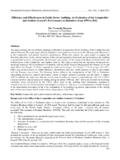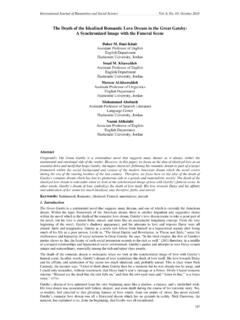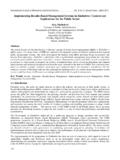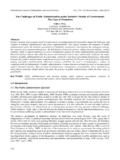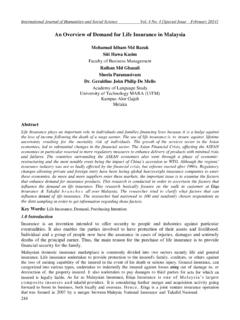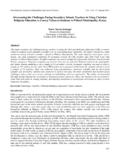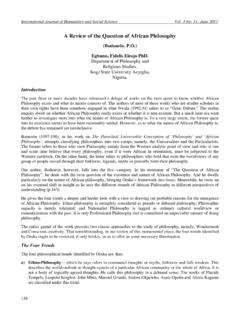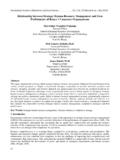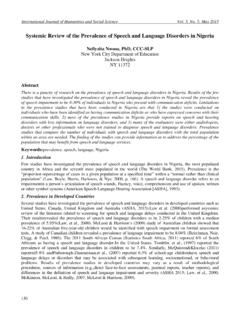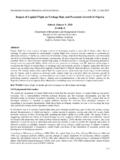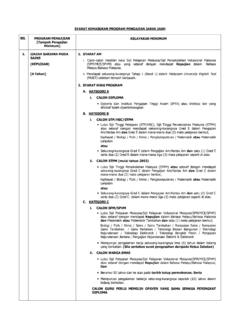Transcription of The Relationship between Reading …
1 International Journal of Humanities and Social Science Vol. 3 No. 13; July 2013. The Relationship between Reading comprehension and Reading Strategy Use among Malaysian ESL Learners Pezhman Zare Department of Language and Humanities Education Faculty of Educational Studies Universiti Putra Malaysia 43400 Serdang, Selangor, Malaysia. Moomala Othman Department of Language and Humanities Education Faculty of Educational Studies Universiti Putra Malaysia 43400 Serdang, Selangor, Malaysia. Abstract The study was an attempt to find out the rate of recurrence of Reading strategy use among Malaysian ESL. learners. It also tried to figure out the possible Relationship between Reading strategy use and Reading comprehension .
2 Moreover, the study was after the influence of gender on the use of these strategies. Ninety five ESL learners participated in the study. A Reading strategy inventory and a Reading comprehension test were used to collect the required data. The data were analyzed through descriptive statistics to determine the frequency of strategies employed by the learners. Independent sample t-test was also employed to find out how the use of strategies varied according to gender. Moreover, Pearson coefficient correlation was used to discover the association between Reading strategy use and Reading comprehension achievement. According to the findings Malaysian ESL learners can be categorized as high strategy users.
3 It was also revealed that significant differences exist between male and female language learners in the use of Reading strategies. Furthermore, the use of Reading strategies had a strong positive correlation with Reading comprehension achievement. Key Words: Reading strategy use. Reading comprehension . Gender. ESL learners Introduction Research studies on Reading comprehension have revealed that Reading is a complex cognitive activity that is crucial for adequate functioning and for obtaining information in current society and requires an integration of memory and meaning construction (Alfassi, 2004). Students need to know how to learn from Reading in order to be able to enter the present literate society and have a successful communication.
4 Reading has been defined as an active process in which readers shift between sources of information, elaborate meaning and strategies, monitor their comprehension , and use the social context to reflect their response (Walker, 2000). Research studies on second/foreign language Reading have consistently confirmed the importance of Reading strategies on developing language learners' Reading comprehension skills (Zare & Nooreen, 2011; Brantmeier, 2002; Slataci & Akyel, 2002; Song, 1998; Carrell, 1989). They argue that strategy use is different in more and less proficient readers, who use the strategies in different ways. Moreover, it has been acknowledged that Reading strategies can be taught to learners and that Reading strategy instruction can benefit all students (Carrell, 1989.)
5 Carol, 2002; Janzen, 1996). It was argued (May, 2001) that what a reader need to focus on is not only every single word in the text but also the semantics of the text. Meanwhile, many language learners mistakenly think that the purpose of Reading is only to learn new vocabulary. 187. Center for Promoting Ideas, USA As a result, they only pay attention to correct pronunciation of each word. Consequently, these learners cannot see the very purpose of Reading as a result of stumbling and mumbling over the isolated words in sentences (May, 2001; Alvermann & Phelps, 1998). Many language learners do not read for the purpose of understanding the writer's message, because they have developed a wrong concept of Reading .
6 In this regard, it is expected that the findings of the current study bring this major issue into a better and clearer stage and help language learners and instructors improve teaching and learning process and achieve their goals. Though, the study seeks answer to the following questions: 1. What is the frequency of Reading strategy use of Malaysian ESL learners? 2. What is the Relationship between Reading strategy use and Reading comprehension success? 3. What is the difference between Malaysian male and female ESL learners in the use of Reading strategy? Review of Literature Reading is a cognitive activity in which the reader takes part in a conversation with the author through the text.
7 On the other hand, Reading strategies are considered as one of the features of cognitive psychology which are essential for a successful comprehension (Zare, 2012; May, 2001; Walker, 2000). Reading strategies has been defined by (Cohen, 1990) as mental processes that readers consciously select to use to complete Reading tasks successfully. Reading strategies was defined (Baker & Boonkit, 2004) as techniques and methods readers use to make their Reading successful (p. 302). Moreover, Reading strategies also has been defined as plans and behaviors for solving problems when faced in constructing meaning (Janzen, 2003). He believes that these strategies range from bottom-up strategies to more comprehensive ones like top-down strategies.
8 Bottom-up strategies are defined as making use of information, which is already present in the data, such as understanding the text by analyzing the words and sentences in the text itself, or looking up an unfamiliar word in the dictionary. On the other hand, top down strategies make use of previous knowledge such as connecting what is being read to readers background knowledge (Janzen, 2003). Some other strategies include evaluating, asking questions, checking for answers, making predictions, summarizing, paraphrasing and translating. In addition, research studies have shown that successful comprehension does not happen automatically. But, it depends mostly on directed cognitive effort, which includes knowledge about and regulation of cognitive processing (Bazerman, 1985; Pressley & Afflerbach, 1995).
9 During Reading , the cognitive effort is expressed through strategies, which are procedural, purposeful, effortful, willful, essential, and facilitative in nature . (Alexander & Jetton, 2000). The reader must purposefully or intentionally or willfully invoke strategies and does so to regulate and enhance learning and comprehension (Alexander & Jetton, 2000). Less competent readers are not well aware of these strategies and of the counterproductive effects of poor strategies, and are not effective enough in their monitoring activities during Reading . Incompetent readers can become skilled readers and develop their Reading skills if they are provided with appropriate instruction about effective strategies and taught to monitor and check their comprehension while Reading .
10 In this regard, (Al Melhi, 2000) has uncovered that some differences exist between successful and less successful readers in terms of their actual and reported Reading strategies, their use of Reading strategies, their strategy awareness, and their perception of the good reader. It is believed (Sheorey & Mokhtari, 2001) that, strategic awareness and monitoring of the comprehension process are significantly important features of competent Reading . Such awareness and monitoring is often in the literature referred to as metcognition which includes knowledge of strategies for processing texts, the ability to monitor one's own comprehension , and the ability to modify strategies when needed (Auerbach & Paxton, 1997).
